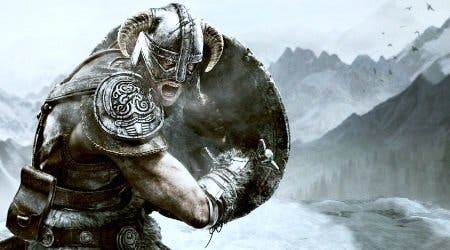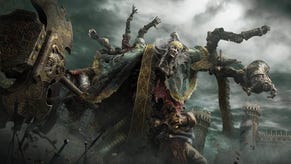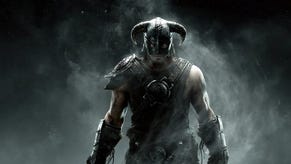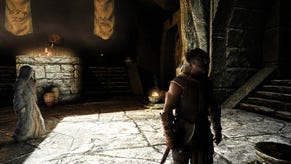Face-Off: Skyrim
PC vs. PS3 vs. Xbox 360.
| - | Xbox 360 | PlayStation 3 |
|---|---|---|
| Disc Size | 3.8GB | 10.16GB |
| Install | 3.8GB (optional) | 4376MB (mandatory) |
| Surround Support | Dolby Digital | Dolby Digital, DTS, 5.1LPCM, 7.1LPCM |
Welcome to Skyrim, Bethesda's long-awaited fantasy opus where you're free to carve out your own adventure. And of course, welcome to the new engine that powers the open-world experience, plainly dubbed the "Creation Engine". Although still partially based on the Gamebryo code that runs behind the scenes in Oblivion and Fallout 3, much has been made by Bethesda of how their new technology has improved character animations, lengthened draw distances on scenery and enhanced the game's AI systems. But put into practice on all three formats, are the differences really big enough to warrant this rebranding?
All the basic tenets of what makes the Elder Scrolls series so engaging are present and correct in this release and translate convincingly to all three platforms. This includes the day-night cycles, the dynamic weather, and the much-hyped NPC routines - each of which help to breathe life into the many miles of its uncharted terrain. Putting the inevitable list of glitches that are associated with such a huge balancing act aside (some of which we'll address later), it was quite rightly awarded a 10/10 in Eurogamer'sSkyrim review for delivering on a very lofty ambition.
Focusing on on the differences between the console versions first, here's our head-to-head video backed up by an exhaustive Skyrim triple-format comparison gallery, beefed up a little with extra shots since it was first posted. The 360 shots and footage are taken with the game running from DVD - as you're most likely aware, there are texture streming issues if you run the game from the Xbox 360 hard drive.
A cursory look at the game reveals that the often-seen gamma level difference between the two consoles is present, giving PS3 more dynamic range in terms of colour at the expense of seeming a little "washed out" in comparison to the Xbox 360 game.
Anti-Aliasing and PS3 Blur
Looking closer, more significant differences start to become apparent. Perhaps the most striking is the marked blurriness to the PS3's image quality in general, particularly on textures. This is not a streaming issue - although each console displays instances of those - but instead something that affects every texture in the game despite the artwork being of equivalent quality to the 360's.
According to our pixel counting tests on high-contrast edges, we can confirm this has nothing to do with the framebuffer itself. Fortunately, both the PS3 and 360 run at the full, promised 1280x720 native resolution. With the possibility of a sub-HD scenario ruled out, we can turn to the next potential culprit for the lack of clarity to the PS3 image: the anti-aliasing methods chosen by each platform.
On 360, the AA situation isn't so clear. Perhaps we have a selective 4x multi-sample anti-aliasing (MSAA) scouting out edges, which in conjunction with the 1280x720 resolution makes it very comparable to the approach taken in Fallout 3. However, other scenes suggest that some form of post processing is the order of the day, as long edges can look very, very clean. Regardless, the overall look on Xbox 360 is very polished indeed, though we note that transparencies (such as waterfalls) can blitz edge-smoothing in some situations.



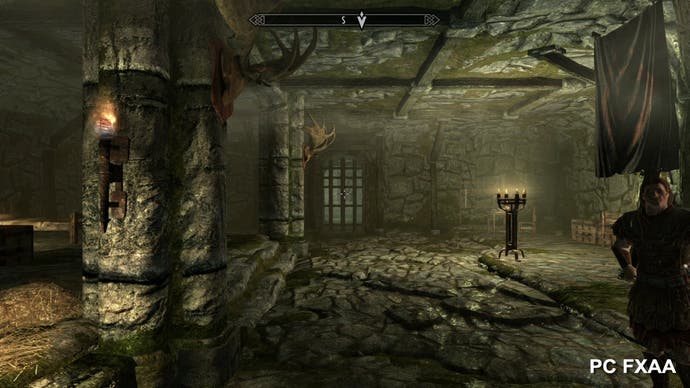
The blurring on PS3 is almost certainly down to the implementation of NVIDIA's FXAA technology, which is also included as an option on PC. Best described as an "intelligent blur", this post-processing technique attempts to identify high contrast edges at a pixel level. FXAA stands for fast approximate anti-aliasing and the "approximate" part of its name is appropriate in that it processes everything within the final frame without prejudice. This includes geometry, 2D elements, and also the content of textures, which leads to the subtle blurring evident on floors and walls. Foliage also gets smoothed off - something that doesn't seem to happen on the Xbox 360 where it often looks as though anti-aliasing is applied before transparent objects and effects are rendered.
Object detail and draw distances are two of the other big advances touted in favour of Skyrim's new engine, and again, it's the PS3 that stands out with a few more compromises in these areas. The SpeedTree engine previously used to render all the flora in Oblivion has since been supplanted by a more dynamic, in-house code that allows higher detailed flora to appear at further afield. This means that foliage (not to mention water) can now react according to wind speed and direction - a very impressive, yet subtle touch that adds greatly to the believability of the world.

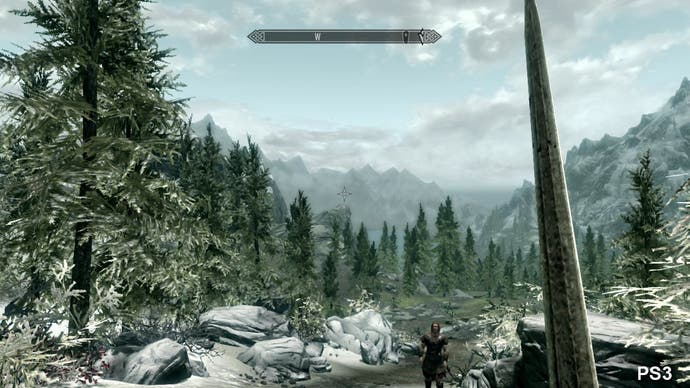
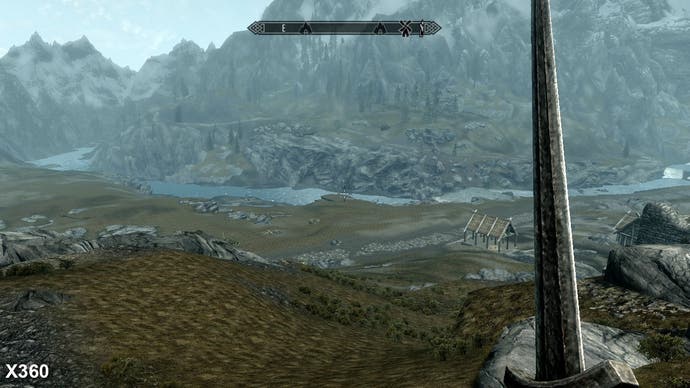
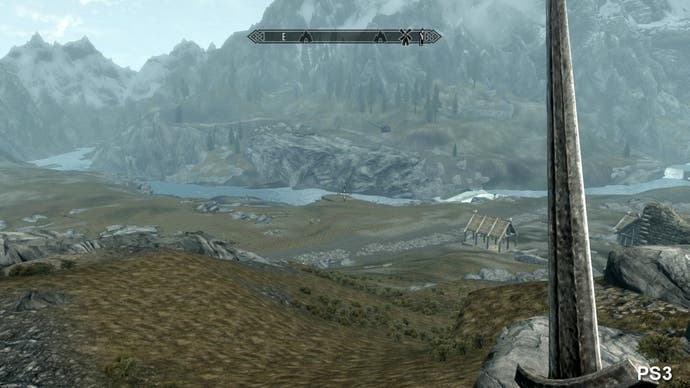
Regarding object detail, there's a reduction in the complexity of trees and plant models on Sony's hardware, with branches being culled outright from trees to reduce CPU load. Factoring in the effects of the post-processing at play on PS3, however, the omissions to detail here are difficult to spot even in a side-by-side comparison. Outside of foliage, all other objects are identical across both versions, suggesting that densely packed forests were a specific point of contention for the hardware at some stage in the PS3 version's design.
Draw Distance and Fade-In
There's a disparity in draw distance settings too (or object fade as it's referred to in the PC's advanced settings) which comes across as a larger issue. The distance at which grass is rendered is equal on both consoles, with the equivalent PC setting being placed at 7 on the relevant slider. It's a different story for objects and landscape geometry such as rocks on mountainsides though. In our "walk-forward" shots on each console, we see the 360 draws in objects from much farther afield, with some rocky formations refusing to swap in on PS3 until the player walks forward a few seconds more.
The issue here is not the absence of objects being visible from a distance, but rather how subtly these objects fade in on each console. Naturally, the greater the distance between the player and the object when this switch occurs, the better it is for the sense of immersion. All three platforms suffer from some obvious pop-in to a point, particularly when running across long stretches around mountainous terrain, but it's fair to say that it does so at a slightly more noticeable range on Sony's platform. Again, both consoles are quite similar in these regards, but as with the shadows, the 360 does offer a slight edge in handling these elements.


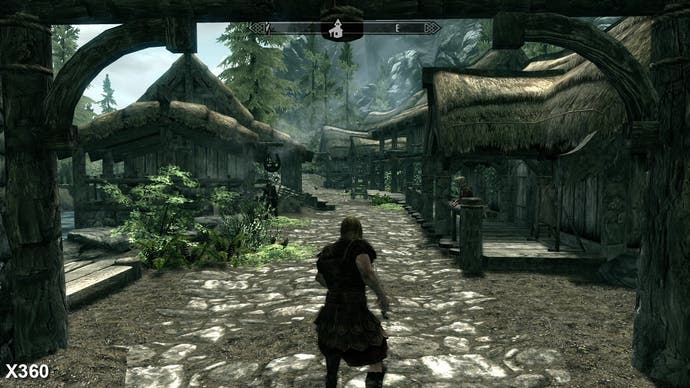
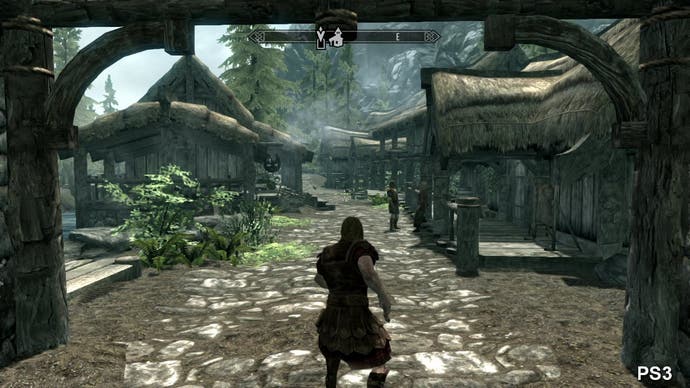
Shadows are the next big distinguishing point between the two console versions. Up close, there's a certain softness to the 360's implementation which may lead some to prefer the PS3's crisper, more defined look. This is only the case when at close range, as detail deteriorates significantly at a distance. From our comparison shots, it appears the draw distance on shadows is slightly further afield on 360, and they tend to pop-in in with more subtlety when running across long stretches of terrain.
By comparison, the PS3's shadows do take a turn for the worse when putting distance between your character and smaller objects, such as NPCs or minor foliage. Compared to the 360, these look significantly pared down and tend to flicker quite noticeably on camera movement, which can be a distraction. Curiously, the shadows projected by buildings on PS3 aren't as greatly affected, and retain their solid, darkened look regardless. The flickering effect can occasionally be a problem on 360 too, as shown during the opening cut-scene. It can even reveal itself when the sun edges across the sky (causing all shadows in a town to jut across), but it is far less prevalent.
The more eagle-eyed may have also noticed that in some of the comparison shots, shadows appear to be completely absent, or pared back on PS3. The issue here appears to be an off-set bias, where the shadow appears to be "sunk in" to the scene. Not a massive issue by any stretch of the imagination but slightly weird nonetheless.
Skyrim Performance Analysis
So with image quality leaning in favour of Microsoft's hardware, how does either console version stack up in terms of performance? Bethesda's games have a history of doing a better job of landing on the 30FPS target on 360, although typically at the cost of tearing when the engine is put under strain. Games like Fallout 3 New Vegas on PS3, meanwhile, opt to take much larger hits to the frame-rate in order to preserve the integrity of each frame - v-sync is engaged and there is no tearing whatsoever. Putting strictly engine-driven cut-scenes and traversal shots of Skyrim through our analysis tools paints a very familiar picture.
The introductory cut-scene reveals that each console has its own issues with rendering. It's a one-off, and while not indicative of the open-world adventuring that makes up the rest of the game, it does demonstrate what happens when multiple NPCs are in the same place at once. Results are very much as predicted: the 360 resumes its previous strategy of building the experience around a fairly consistent 30FPS update, although it is prone to dropping v-sync where necessary. On the PS3, the complete opposite is true, whereby it's determined to bear the brunt of these frame-rate drops in order to keep v-sync engaged. The basic difference, then, is that one tears under strain, and the other produces a perceptible judder in equivalent situations.
The root causes for these deficits in performance are remarkably like-for-like. The problem areas include multiple light sources, the mist effects above waterfalls, and the presence of too many NPCs in town centres, all of which can bring the PS3 down to 25FPS. Through it all, the 360 is committed to holding out at 30FPS by simply disengaging v-sync, with frame-rate drops on the console during traversal being a rarity. In the general run of play, the tearing we see is a worthwhile trade-off in order to preserve controller response, which would have otherwise been impacted by lower frame-rate refresh.
All told, performance in these sections is very impressive given the ambition of the game, and the scope of the play-field. However, operating under similar conditions, it's worth mentioning that the PS3 can drop frames for one more reason; namely, stuttering, which occasionally crops up in larger environments when geometry decides to pop in on the horizon. This isn't as much of a distraction as it was in Fallout 3 New Vegas, but the issue can potentially be exacerbated by faster walking speeds afforded by stat increases, or even different modes of transport.
So while performance is respectable during passive, exploratory sections of the game, it must be said that the issues hinted at with rendering multiple light sources and 4+ NPCs do become more glaring when taken to an extreme. For example, a Warrior character build can wield fire spells from the off - an effect that produces a dynamic, moving light source. When placed into a candle-lit arena with other magic users in combat, performance on PS3 drops down to 20FPS or lower for protracted periods of play, while the 360 tears constantly in a bid to prevent going further below 25FPS.
This is not an ideal situation on either platform, of course, but in terms of sheer playability stemming from sharper controller response, the 360 version is clearly the one optimised best for most situations. The tearing is indeed aggressive at these points, and that can understandably be off-putting for some players (and may well influence your purchase). However, there's more to be gained in translating the player's inputs to the game without delay than what is ultimately lost here in image quality.
Speaking of controller response, it's worth mentioning that players of the PS3 version are reporting an increase in controller latency once save files reach a certain size (the established estimate being 5.5MB). This also proved to be an issue in previous Bethesda titles for the console, harking all the way back to the days of Oblivion, which makes it all the more surprising a patch hasn't come to save the day yet.
In the here and now, the issue hasn't manifested during our gameplay, but a colleague has switched over to the Xbox 360 version after 18 hours of play on PlayStation 3, describing the difference as "revelatory" and the reports from other gamers make for some grim reading. This is something we'll try to look at in more depth as we attempt to make the issue manifest here. Stay tuned.
A PC the action
Like many developers now making a big splash on consoles, the PC was the starting point for Bethesda. Its pedigree on PC-side development stretches all the way back to the late eighties, and it has since been the home to every Elder Scrolls game from Arena through to Oblivion.
Although times have changed, PC fans' expectations for their beloved platform have not. Mod tools are expected. Improved textures, driver-based SSAO support, and custom tailoring via .ini file tweaks are expected. Although it was recently confirmed during Game Informer's Q&A session with director Todd Howard that 360 version was for all intents and purposes being treated as the lead platform, it's a relief to see the PC version has been given a little love and attention. Here's how the PC game looks in comparison to the Xbox 360 version, and there's a PS3/PC mirror of this video just a click away.
After the Steam download and install, weighing in at 5740MB, we went with the recommended settings for our chosen setup - a 2.4GHZ Q6600 quad core system coupled with 4GB of DDR2 RAM and a 1GB Radeon 6870 GPU - all relatively cheap components that entitled us to the "High" settings bracket. This comes pre-set with everything from 8x MSAA and 8x anisotropic filtering to reflections of land, objects and trees (but not sky). Put into comparison with the 360 version in like-for-like 720P footage, the image quality is at the very least on par, and often improved in discrete ways.
Put under close inspection, many of the texture assets seem remarkably similar to consoles, although the tops of castle walls are clearly using different textures entirely. Meanwhile, in Helgen Keep, the addition of more detailed specular highlights on the columns and flooring adds greater definition to the scene. Outdoor shots also reveal differences in object placement; not only do trees look fuller by comparison, by virtue of having yet more branches over the 360 version, but there are simply more of them dotted around the landscape. Alongside the longer draw distance on shadows, these improvements all serve to make the world look richer and more alive from a distance.


As previously mentioned, FXAA is also supported on PC. This is a boon to those running graphics cards with too little VRAM to capably factor in MSAA, and is welcomed as a relatively low-cost alternative. The implementation here is of higher precision than the PS3's offering too and when used in combination with standard MSAA can deliver a delightfully smooth overall image. Meanwhile, although native screen-space ambient occlusion (SSAO) is not officially supported in the advanced control panel, the effect is possible on NVIDIA cards by means of tweaks to driver settings. It's a similar situation for effects such as self-shadowing trees and land shadows, both of which can be edited in via Skyrim's .ini file.
Regarding actual playability on this PC build, it's slightly disappointing to see that the game's support of only two threads is bottlenecking performance in such a way that we were denied a pure 60FPS experience. The lack of support for quad-core processors suggests that the engine upgrade isn't quite as advanced as many would have liked - the report by Tom's Hardware on PC Skyrim performance is very enlightening.
Nevertheless, we made the most of the situation by forcing a 30FPS cap to avoid the wild fluctuations in response. For monitors operating at a 60Hz refresh with v-sync engaged, forcing this lower frame-rate works well in producing judder-free camera motion, and at least this target frame-rate was more sustainable than on consoles and it has to be said that Skyrim definitely benefits from being rendered at higher resolutions.
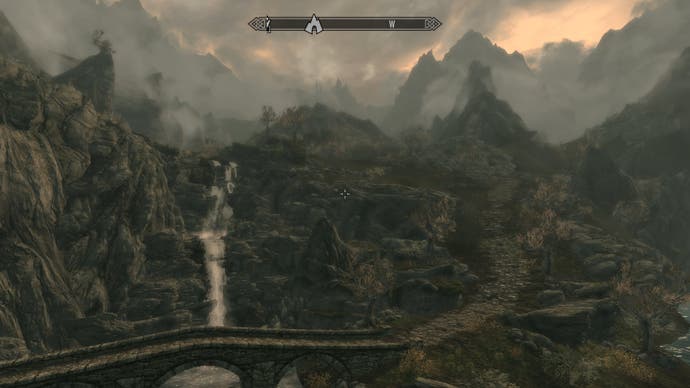


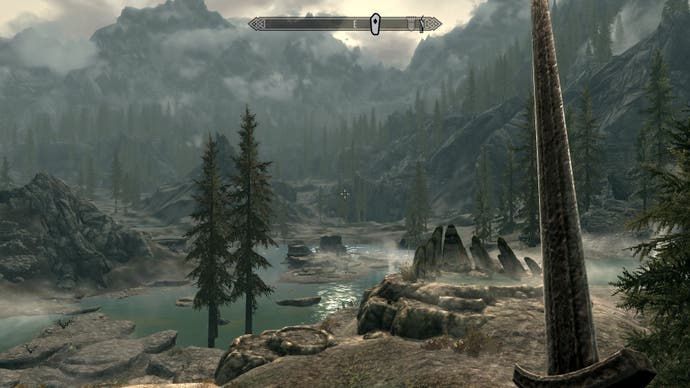
However, in common with the lack of polish on other versions, there have been problems with bugs on PC - input lag being one of them. For those affected, this can be resolved by yet another simple .ini tweak, where changing the "iPresentInterval" value to 0 helps alleviate the issue for most people. Another workaround to this is simply using the 360 controller - a whole-hearted addition that activates seamlessly once plugged in. You do lose the greater range of control afforded by a keyboard's hotkeys, but it's comforting to know that the option is there and kitted out with a fully redesigned user interface.
Skyrim: The Digital Foundry Verdict
So to round up, this is a valiant overall effort by Bethesda at delivering a bewilderingly huge fantasy game to three platforms, each of varying technical strengths and weaknesses. But, despite their best and most well-meaning efforts at achieving parity on both consoles, we can confirm that the 360 does command a clear advantage over the PS3 when it comes to both image quality and performance. Even with the PS3's mandatory install, the geometry pop-in in certain areas is more distracting than it is on Microsoft's platform, and the light blur introduced by its post-processing tends to affect the clarity of the image as a whole.
For those lucky enough to be multi-platform owners, the 360 version also comes recommended for its more stable frame-rate. With that being said, they're both perfectly acceptable taken on their own terms, and the core of Skyrim's complex open-world design remains entirely intact on each. However, the save game issue on PS3 remains a concern and we'll continue to carry on playing there in order to see if its manifestation necessitates a blog update.
Meanwhile, it goes without saying that the PC offers the best-case-scenario experience, with mod tools likely set to add to the long-term appeal of the game. If you can afford even a medium-level rig, and would like to dabble in the range of tweaks possible to the game's engine, this option is well worth your time and money.
